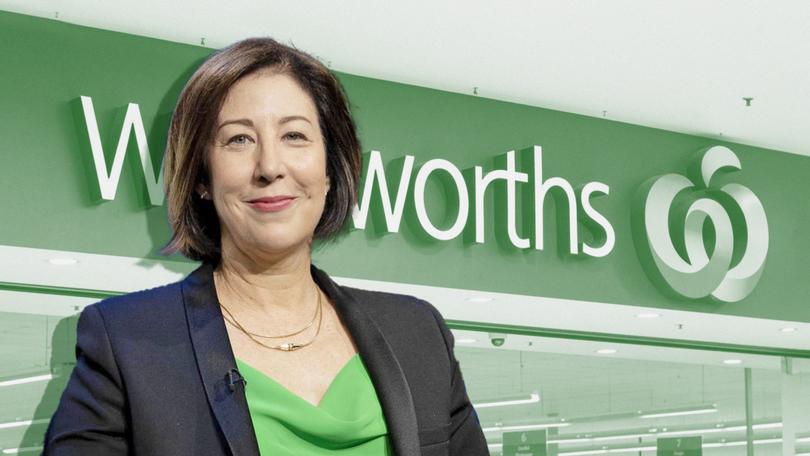How Woolworths can turn it around in the face of regulatory scrutiny, political pressure to reduce food prices

Woolworths boss Amanda Bardwell is set to have her hands full in 2025 trying to execute a turnaround plan for the embattled grocer, experts say, following a string of scandals last year.
The country’s biggest supermarket chain, along with rival Coles, is in the midst of trying to rebuild customer trust in the face of regulatory scrutiny and political pressure to reduce food prices.
And while both supermarkets are facing mounting criticism, having been accused of tricking customers with fake discounts on hundreds of products by the competition watchdog, Woolworths has felt it the worst.
Sign up to The Nightly's newsletters.
Get the first look at the digital newspaper, curated daily stories and breaking headlines delivered to your inbox.
By continuing you agree to our Terms and Privacy Policy.In early 2024, Woolworths faced backlash over its decision to pull Australia Day-themed merchandise in-store.
Weeks later in February, then-CEO Brad Banducci surprised the market with his resignation following a trainwreck television interview where he struggled to answer questions about the lack of competition in the supermarket sector.
The supermarket capped off a disastrous year by revealing a $140 million hit in lost food sales as a result of a 17-day strike by Woolworths warehouse workers that left shelves bare across Victoria, the ACT and New South Wales.
With Woolworths set to unveil its half-year results at the end of February, Wilson Asset Management analyst Hailey Kim will be looking for any signs of improving stock levels following the disruption.
“At the February result … they also give a bit of a commentary around how early January has been (trading), so everyone will be focusing on whether the stock availability is stabilising,” she told The West Australian.
“It might be a bit too soon for (Woolworths) to have regained the sales momentum but any early signs of that coming could be viewed quite positively.”
Ms Kim will also look for commentary on how Ms Bardwell plans to keep a lid on rising costs.
“It’s all about the market … having a good understanding of what (Amanda’s) strategy is, whether it’s a continuation of her predecessor Brad’s (strategy) or if there’s a dramatic shift,” she said.
“We think Woolworths is very well invested in, has a very good asset base, has a very good business and brand, so we would like to see what the strategy will be and how (Amanda will) look to deliver over the next 12 months.”
As households remain under significant financial stress, marketing and retail analyst Barry Urquhart said Woolworths needed to convince consumers it was working hard to deliver “everyday lower prices”.
“To win back brand integrity . . . consumers have to be able to say,” ‘Whenever I go to Woolworths I can get that special and I can get that value’,” he said.
“That’s the fundamental pillar of building up a relationship because it’s peace of mind purchasing.”
Mr Urquhart said consumers today were looking at retailers through the vista of the cost of living crisis.
“That’s a very raw, emotive sentiment that I don’t think too many businesses can possibly win the hearts and minds of people at large,” he said.
On top of that, customers have more choice than ever — in-store and online — and Woolworths was increasingly competing with rivals Aldi, Costco, Amazon and even Chemist Warehouse.
Mr Urquhart said brand loyalty was out the window.
“it’s not about loyalty. Consumers today . . . are smart shoppers, they are alive, they are alert,” he said.
“(Consumers) will buy opportunistically when they see good value.”
Woolworths in September faced calls from major investors to ditch its discount department chain Big W and spin off its New Zealand division.
Investors wanted the retailer to focus on turning around its local supermarkets where sales growth had been slower than Coles in recent years.
In the half-year to the end of June 2024, sales growth at Woolworths’ Australia food business — which includes the company’s local supermarkets and its e-commerce arm WooliesX — grew just 1.8 per cent, while Coles lifted 5.2 per cent.
Sales at Woolworths continued to lag behind in the first eight weeks of the new financial year, recording a 3 per cent growth compared with Coles’ 3.7 per cent increase.
And Coles stock is also outperforming Woolworths shares. In the past year, shares in Woolworths have fallen 16 per cent to $29.95 and Coles lifting 23.2 per cent to $19.10.
Australian Shareholders’ Association chief executive Rachel Waterhouse said Woolworths was a mainstay of many investment portfolios, reflecting its importance to both the retail sector and the broader economy.
She added Woolworths was a company of interest for retail investors. The company’s annual general meeting in October revealed shareholder concerns about environmental risks, like salmon farming, and employee conditions, such as wages and rostering.
“Despite these challenges, investors seem optimistic that Woolworths can restore its reputation through initiatives like own-brand value products and e-commerce growth,” Ms Waterhouse said.
“While the share price performance has been underwhelming, shareholders appear to recognise the company’s efforts to address stakeholder needs and rebuild trust.”
On top of the legal proceedings, Coles and Woolworths are also at the centre of an inquiry launched by the Australian Competition and Consumer Commission, which is looking into how they set prices.
A final report from the ACCC on the supermarket sector is due by February.
Ms Bardwell took over from Mr Banducci last September to become Woolworths’ first female chief executive. She had been the managing director of Woolworths’ e-commerce division.
“When you think of her timeline, it’s been less than three months in the role properly,” Ms Kim said.
“There’s been a lot of disruptions as soon as she stepped into the role, so I’m sure she’ll try and have a platform to communicate her own strategy to the market in due course.”
Mr Urquhart warned 2025 would be a tough year mainly for smaller businesses.
“Last year we saw up to and including October a doubling of the number of businesses that have gone into administration,” he said.
“We’ve done some analysis and we believe that will reach its peak in March because lot of people are still holding out hoping for a good Christmas.”
Originally published on The Nightly

